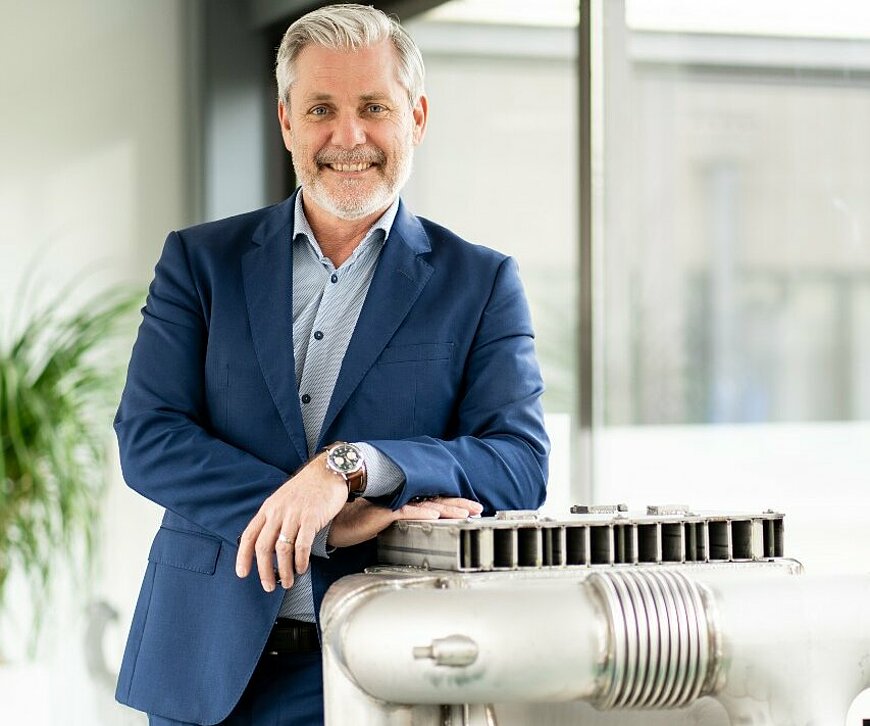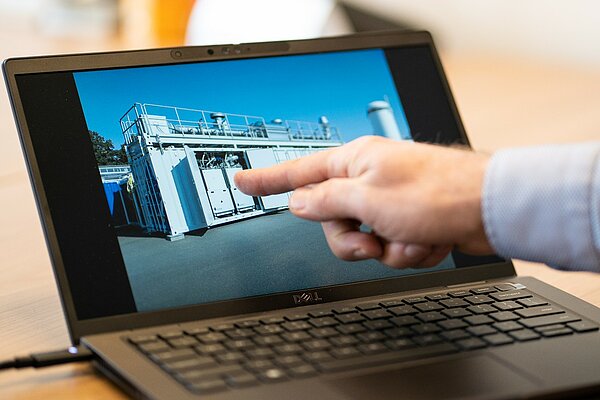Ted Straten, Bosal: ‘This way, we get ahead of the rest of the world.’

Interview with Ted Straten, BOSAL about Green Transport Delta - Hydrogen
Please introduce yourself!
My name is Ted Straten. I am working as Vice President Strategy and New Business for BOSAL, a leading manufacturer in mobility and energy. We currently have sixteen industrial sites, six R&D centers and 1,700 employees worldwide.
For decades, our core business was manufacturing and supply of exhausts. But internal combustion engines are under pressure. To meet climate goals, we must reduce CO2 emissions worldwide. And it is important to include such trends in our business strategy. Our competencies in materials and technical design combined with our global branch network will help us future proof our other products as well. One of our key competencies over the past hundred years has been the use of metals at high temperatures. We know how and which materials we need to design products with the right lifespan. That is why our focus is on the production of high-temperature heat exchangers for fuel cells and electrolyzers.
Currently, we are already manufacturing and supplying modules for electrolyzers at huge solar and wind farms. We are looking at ways to also use this technology in mini grids around cities, business parks, and residential areas to generate, store, and use energy locally.
We also focus on the production of heat exchanging systems for high-temperature fuel cells. A fuel cell is a device that converts hydrogen and oxygen into electricity, heat, and water without releasing any hazardous substances.
This year, BOSAL, a true Dutch family business, is celebrating its 100th year anniversary. A good reason for a party after the summer.

What is the objective of the Green Transport Delta-Hydrogen pillar you are working on?
In the next two years, we will start producing our first-generation Hot Balance of Plant, which are heat exchanging systems around the stack, the base of a fuel cell. The cells form stacks, which are the building blocks of large energy systems. At BOSAL, we ensure that the heat used around the stack is optimally recovered and utilized. Don’t forget that a fuel cell’s stack also has an exhaust. It makes sense to optimally use the energy released via the exhaust to increase the fuel cell’s efficiency. That’s what we do for the stationary industries that use these systems for data centers, for example.
With Green Transport Delta, we are also trying to adapt stationary technology for use in modules on mobile applications. To do this, we must meet different requirements. The skew angle and the number of vibrations and accelerations the system must be able to withstand are subject to restrictions. The impact of water and sand also has to be taken into account when used in the shipping or construction industry. The conditions in the mobility sector are different. We must develop the system in such a way that it can be used in multiple applications.
Ultimately, the whole sector will benefit from mass production. One of the challenges we are faced with in the energy transition is to make sure the new technology remains affordable, that cost-effective methods are used for production and that the appropriate cost-effective technology can be used in various applications. This is also good for the Dutch position on the global market.
It made sense for us to participate in GTD-H. We get more things done by working together than by doing it alone. There are many useful competencies available within the Netherlands. That is why we, jointly with TNO, RAI Automotive Industry NL, and Brainport, have been looking for partners to jointly develop new systems and we have contacted these parties for the GTD-H project. Like VDL for example, an expert in assembling and automating systems. Or Circonica, a company that has developed a promising stack technology that can be produced at low cost. TNO is the right partner for system modeling and software design, and DLS has knowledge of vehicle integration. Or Westport, which develops fuel systems for internal combustion engines. Everyone brings their own strengths, competencies, and IP.
Because of our international position, we understand better than anyone the developments in the field of fuel cells and electrolysis. We know what to expect. The technology we jointly develop with our Dutch partners can easily be rolled out to the rest of the world.
Why is it so important to participate in this project?
It is important to work together, especially now. BOSAL is a company in transition, and we see that our current market is under pressure. Green Transport Delta is helping us and the other partners, with the help of some government funding, to work together to create a new robust Dutch manufacturing industry. But of course, all partners are also investing in the project. This way, we shape the collaboration and invest in the development of new technologies. As that takes a lot of money and effort.
There are many advantages to high temperature cell technology. One advantage is that the high-temperature fuel cell has a high efficiency and that it works with any fuel. This versatility can be of key importance in the fuel transition.
We all want to replace fossil petrol and diesel with hydrogen. However, worldwide transportation of hydrogen is quite difficult. To transport hydrogen, we use e-fuels such as ammonia or methanol. A big advantage of high-temperature fuel cells is that these blends can be directly used in the cell.
In addition to its high efficiency, a fuel cell is very flexible in terms of fuel. But it also has some disadvantages. The cell operates at high temperature, which means, for example, that it takes quite some time before a fuel cell has started up. And that it is difficult to quickly change the desired output. If you want to use this system in the mobility sector, you have to carefully look at how to deal with the fuel cell's lack of response to power output, and how to keep the cell at the right temperature. This is exactly why we are participating in GTD-H; to develop new strategies and materials to make this technology work.
How will these innovations affect the Dutch citizens?
There are some things that people can easily recognize; cars and engines can run on hydrogen, but fuel cells will also be used for heavy transport, trucks, and buses. The beauty of a fuel cell is that it makes no noise and emits no CO2. Trucks and buses are going to be quieter.
We will all notice that our environment will be less polluted. Not only in terms of pollution from gases or aggressive substances, but also in terms of noise pollution.
I expect the transport industry to scale up the use of fuel cells around 2030. Then, the number of electric trucks with battery packs will significantly increase. For highway transportation, trucks will use both batteries and fuel cells.
I really believe in a combination of battery technology and hydrogen fuel cells for long-distance transportation. When using this combination, you avoid lengthy charging breaks when on the road. The advantage of a fuel cell is that it provides continuous power, continuously fully charging the battery pack. Hence, you don't need extra batteries because you always carry a charger. The energy that is stored aboard the vehicle is hydrogen. The fuel cell continuously converts hydrogen into electricity. It works differently for peak load, however. The energy needed for peak load is provided by the battery pack instead of the fuel cell. So, a fuel cell will always be used in combination with a small battery pack.
Of course, the partners within the GTD-H project are also looking at infrastructure. For example, Gasunie has certain ideas about the use of existing gas pipelines. The Netherlands also has storage tanks, refineries, pipelines, and gas stations. E-fuels are therefore a good option to use as plug-in fuel in the current infrastructure. Recently, a decision was made at European level about the future of Ten-T (Trans-European Network). That is a network of transport routes throughout Europe. That decision stipulates that these routes should contain a hydrogen refueling station and a charging station for heavy transport every 200 and 120 km, respectively. So ultimately, we are moving towards a hydrogen infrastructure in Europe.

What parties would you like to work with to achieve success and what are the topics people can contact you for?
In 2029, we want to open the first plants for manufacturing of hydrogen systems. To realize this, the technology must be ready by 2027. This is an ambitious plan. We need to industrialize the technology for high volume production at low cost.
We are not only looking at cost reduction, but also need to develop production tools and production technology. Therefore, we need knowledge on how to further develop fuel cells and electrolysis modules for cheap production in large volumes. For example, if we want to supply 10,000 systems a year, we need to manufacture millions of heat-exchanging cells. Every few seconds, we must be able to produce such a cell. Furthermore, we must check if the quality of the cell is okay; is it leak-proof, are the joints properly welded, are the materials nicely stacked. In short, can the cell be used for assembly into a larger block. This means that we have to look at very different quality control methods. We currently don't have that technology. We are looking for companies in other branches of technology that already know these kinds of processes. So, we can save on development costs and time.
We can use this new technology to build up a good position internationally. And we can even start worldwide production because we are already active in many regions. Companies that can do the same and that have the ambition to use this technology outside the Netherlands are welcome to contact us.
The Netherlands wants to create new earning power for the industry. I am glad that the manufacturing industry is also included. Fortunately, we have clearly understood that it is one of the drivers of the Netherlands. Perhaps that is because we are forced to think about it. But also, because we understand that the Netherlands has many companies and a lot of technology that can be used to jointly create a new industry. And as far as we are concerned that industry should be focused on hydrogen, e-fuels, electrolyzers and fuel cells. Because that will safeguard the Netherland’s future. It will enable us to gain a good position in the world market in the decades to come.